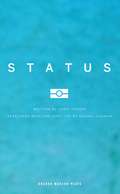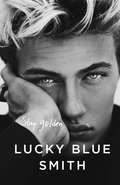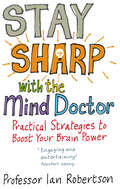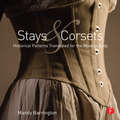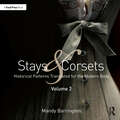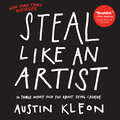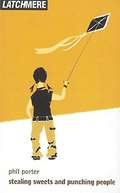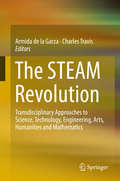- Table View
- List View
Statistical Models of Shape: Optimisation and Evaluation
by Rhodri Davies Carole Twining Chris TaylorThe goal of image interpretation is to convert raw image data into me- ingful information. Images are often interpreted manually. In medicine, for example, a radiologist looks at a medical image, interprets it, and tra- lates the data into a clinically useful form. Manual image interpretation is, however, a time-consuming, error-prone, and subjective process that often requires specialist knowledge. Automated methods that promise fast and - jective image interpretation have therefore stirred up much interest and have become a signi?cant area of research activity. Early work on automated interpretation used low-level operations such as edge detection and region growing to label objects in images. These can p- ducereasonableresultsonsimpleimages,butthepresenceofnoise,occlusion, andstructuralcomplexity oftenleadstoerroneouslabelling. Furthermore,- belling an object is often only the ?rst step of the interpretation process. In order to perform higher-level analysis, a priori information must be incor- rated into the interpretation process. A convenient way of achieving this is to use a ?exible model to encode information such as the expected size, shape, appearance, and position of objects in an image. The use of ?exible models was popularized by the active contour model, or ‘snake’ [98]. A snake deforms so as to match image evidence (e.g., edges) whilst ensuring that it satis?es structural constraints. However, a snake lacks speci?city as it has little knowledge of the domain, limiting its value in image interpretation.
Statistics for Linguists: An Introduction Using R
by Bodo WinterStatistics for Linguists: An Introduction Using R is the first statistics textbook on linear models for linguistics. The book covers simple uses of linear models through generalized models to more advanced approaches, maintaining its focus on conceptual issues and avoiding excessive mathematical details. It contains many applied examples using the R statistical programming environment. Written in an accessible tone and style, this text is the ideal main resource for graduate and advanced undergraduate students of Linguistics statistics courses as well as those in other fields, including Psychology, Cognitive Science, and Data Science.
Statistics for Linguists: An Introduction Using R
by Bodo WinterStatistics for Linguists: An Introduction Using R is the first statistics textbook on linear models for linguistics. The book covers simple uses of linear models through generalized models to more advanced approaches, maintaining its focus on conceptual issues and avoiding excessive mathematical details. It contains many applied examples using the R statistical programming environment. Written in an accessible tone and style, this text is the ideal main resource for graduate and advanced undergraduate students of Linguistics statistics courses as well as those in other fields, including Psychology, Cognitive Science, and Data Science.
Status (Oberon Modern Plays)
by Chris Thorpe Rachel ChavkinStatus is a show about someone who doesn't want his any more. About running away from the national story you're given. About who is responsible for that story and what might happen to it if you give it up.A globe-spanning journey of attempted escape, with songs along the way. Status springs from conversations about who we might be, and whether your country needs you more than you might need it.
Stay Cool: A Design Guide for the Built Environment in Hot Climates
by Holger Koch-NielsenIn hot dry or warm humid climates, more than half of the urban peak load of energy consumption is used to satisfy air-conditioning demands alone. Since the urbanization rate in developing countries is extreme, the pressure placed on energy resources to satisfy the future requirements of the built environment will be great, unless new, more cost-effective measures can be introduced. Stay Cool is an essential guide for planning and design using active design principles and passive means to satisfy human comfort requirements specifically in these climate zones, based on examples of traditional and modern constructions. The book demonstrates how a design strategy for urban environments and individual buildings, incorporating naturally occurring resources and specific energy-efficient technologies, can create a location, form and structure that promote significant energy-savings. Such strategies can be applied to low cost housing, or indeed to any other buildings, in order to improve comfort with passive means and low energy budgets. Following an outline of climatic issues, characteristics and thermal comfort requirements, the book details the available techniques and technologies that can be used to shape both built and external environments, the building envelope, material selections and natural ventilation and cooling methods to satisfy both human requirements and the need for energy efficiency. It also includes an active design checklist and summary of available design checking tools, a rehabilitation guide for existing urban, building and external environments, and solar charts. Planners, architects, engineers, technicians and building designers will find Stay Cool an inspirational guide and an essential reference when working with planning and design of the built environment in hot dry and warm humid climate zones. It will also be of benefit to students, academics and researchers with an interest in sustainable and energy-efficient architecture techniques and practice.
Stay Cool: A Design Guide for the Built Environment in Hot Climates
by Holger Koch-NielsenIn hot dry or warm humid climates, more than half of the urban peak load of energy consumption is used to satisfy air-conditioning demands alone. Since the urbanization rate in developing countries is extreme, the pressure placed on energy resources to satisfy the future requirements of the built environment will be great, unless new, more cost-effective measures can be introduced. Stay Cool is an essential guide for planning and design using active design principles and passive means to satisfy human comfort requirements specifically in these climate zones, based on examples of traditional and modern constructions. The book demonstrates how a design strategy for urban environments and individual buildings, incorporating naturally occurring resources and specific energy-efficient technologies, can create a location, form and structure that promote significant energy-savings. Such strategies can be applied to low cost housing, or indeed to any other buildings, in order to improve comfort with passive means and low energy budgets. Following an outline of climatic issues, characteristics and thermal comfort requirements, the book details the available techniques and technologies that can be used to shape both built and external environments, the building envelope, material selections and natural ventilation and cooling methods to satisfy both human requirements and the need for energy efficiency. It also includes an active design checklist and summary of available design checking tools, a rehabilitation guide for existing urban, building and external environments, and solar charts. Planners, architects, engineers, technicians and building designers will find Stay Cool an inspirational guide and an essential reference when working with planning and design of the built environment in hot dry and warm humid climate zones. It will also be of benefit to students, academics and researchers with an interest in sustainable and energy-efficient architecture techniques and practice.
Stay Golden
by Lucky Blue SmithWhile most kids my age were sitting in English class waiting for the bell to ring, I was thrown into the deep end of the fashion and modeling pool. From sixteen to eighteen years old, I was circling the globe and doing things I had never before imagined. I broke the rules and shattered expectations of what a normal male model could do. I wanted to write this book to connect more with my friends and fans, to share experiences, and to pass on a few things I have learned along the way. I hope that it will help and inspire others to be more confident and follow their dreams. Scouted at the age of ten, signed to an international modeling agency by twelve, and now considered the most in-demand model at only eighteen, Lucky Blue Smith is #lucky.Get a front row look at the fashion and modeling world, through the eyes of Lucky Blue Smith, as he shares personal stories, never-before-seen photographs and intimate letters from his family and friends.Witty, charming, and totally honest, Lucky reveals all, connecting with his fans like never before—from rock ’n’ roll Christmases at the Smith's to Levi’s in Hollywood, from The Atomics to GQ, Lucky will inspire all to be confident, to follow their dreams, and to always STAY GOLDEN.
Stay Sharp With The Mind Doctor: Practical Strategies to Boost Your Brain Power
by Ian RobertsonA simple and fun mind workout that will give you the mental sharpness of someone 10 years younger.New research in neuroscience - the study of mind-brain function - has proved that, just as physical health and fitness can be transformed by diet and exercise, so your brain can be tuned to maximum sharpness. It is also possible to avoid, and even reverse, the effects of mental aging. Key discoveries include:-Exercise actually grows your brain and improves your memory -The foods and vitamins that make you sharper-Use your brain if you don't want to lose it-Unstress your brain - it doesn't like it
Stay Tuned: A History of American Broadcasting (Lea’s Communication Series)
by Christopher H. Sterling John Michael KittrossSince its initial publication in 1978, Stay Tuned has been recognized as the most comprehensive and useful single-volume history of American broadcasting and electronic media available. This third edition has been thoroughly revised and updated to bring the story of American broadcasting forward to the 21st century, affording readers not only the history of the most important and pervasive institution affecting our society, but also providing a contextual transition to the Internet and other modern media. The enthusiasm of authors Christopher H. Sterling and John Michael Kittross is apparent as they lead readers through the development of American electronic mass media, from the first electrical communication (telegraph and telephone); through radio and television; to the present convergence of media, business entities, programming, and delivery systems, including the Internet. Their presentation is engaging, as well as informative, promoting an interest in history and making the connections between the developments of yesterday and the industry of today. Features of this third edition include: *chronological and topical tables of contents; *new material reflecting modern research in the field; *a new chapter describing historical developments from 1988 through to the current day; *an expanded bibliography, including Web site and museum listings; *an updated and expanded glossary and chronology; and *extensive statistical data of the development of television and radio stations, networks, advertising, programming, audiences, and other aspects of broadcasting. Designed for use in undergraduate and graduate courses on the history of American mass media, broadcasting, and electronic media, Stay Tuned also fits well into mass communication survey courses as an introduction to electronic media topics. As a chronicle of American broadcasting, this volume is also engaging reading for anyone interested in old radio, early television, and the origins and development of American broadcasting.
Stay Tuned: A History of American Broadcasting (Routledge Communication Series)
by Christopher H. Sterling John Michael KittrossSince its initial publication in 1978, Stay Tuned has been recognized as the most comprehensive and useful single-volume history of American broadcasting and electronic media available. This third edition has been thoroughly revised and updated to bring the story of American broadcasting forward to the 21st century, affording readers not only the history of the most important and pervasive institution affecting our society, but also providing a contextual transition to the Internet and other modern media. The enthusiasm of authors Christopher H. Sterling and John Michael Kittross is apparent as they lead readers through the development of American electronic mass media, from the first electrical communication (telegraph and telephone); through radio and television; to the present convergence of media, business entities, programming, and delivery systems, including the Internet. Their presentation is engaging, as well as informative, promoting an interest in history and making the connections between the developments of yesterday and the industry of today. Features of this third edition include: *chronological and topical tables of contents; *new material reflecting modern research in the field; *a new chapter describing historical developments from 1988 through to the current day; *an expanded bibliography, including Web site and museum listings; *an updated and expanded glossary and chronology; and *extensive statistical data of the development of television and radio stations, networks, advertising, programming, audiences, and other aspects of broadcasting. Designed for use in undergraduate and graduate courses on the history of American mass media, broadcasting, and electronic media, Stay Tuned also fits well into mass communication survey courses as an introduction to electronic media topics. As a chronicle of American broadcasting, this volume is also engaging reading for anyone interested in old radio, early television, and the origins and development of American broadcasting.
Stays and Corsets: Historical Patterns Translated for the Modern Body
by Mandy BarringtonStays and Corsets: Historical Patterns Translated for the Modern Body goes a step beyond traditional historical costuming texts by not only providing you with historical pattern diagrams and information, but by showing you how to adapt these patterns to the contemporary body shape. Using her original pattern-drafting system, author Mandy Barrington will show you how to draft a historical pattern for a modern body shape, while still retaining an accurate historical silhouette. Each pattern has been generated from an original stay, corset, or pattern taken from a historical garment. The instructions to follow these new patterns are designed to accommodate any size of female figure, allowing you to avoid extremely difficult, time consuming, and inaccurate historical pattern re-sizing Requiring only basic prior knowledge of pattern drafting, all calculations have been worked out for the costume maker and are provided in simple tables accompanied by easy-to-read, step-by-step diagrams that clearly show how the historical pattern is plotted onto the female basic block, coupled with photographs of the constructed stays and corsets.
Stays and Corsets: Historical Patterns Translated for the Modern Body
by Mandy BarringtonStays and Corsets: Historical Patterns Translated for the Modern Body goes a step beyond traditional historical costuming texts by not only providing you with historical pattern diagrams and information, but by showing you how to adapt these patterns to the contemporary body shape. Using her original pattern-drafting system, author Mandy Barrington will show you how to draft a historical pattern for a modern body shape, while still retaining an accurate historical silhouette. Each pattern has been generated from an original stay, corset, or pattern taken from a historical garment. The instructions to follow these new patterns are designed to accommodate any size of female figure, allowing you to avoid extremely difficult, time consuming, and inaccurate historical pattern re-sizing Requiring only basic prior knowledge of pattern drafting, all calculations have been worked out for the costume maker and are provided in simple tables accompanied by easy-to-read, step-by-step diagrams that clearly show how the historical pattern is plotted onto the female basic block, coupled with photographs of the constructed stays and corsets.
Stays and Corsets Volume 2: Historical Patterns Translated for the Modern Body
by Mandy BarringtonIn this second volume of Stays and Corsets, Mandy Barrington continues to create historical patterns for a modern body shape. This book contains all new corset patterns with a range of silhouettes that span over 300 years, from the late 16th century to the early 20th century. The corset patterns are generated from an original historical garment and have been designed for a wide range of female figures and sizes. The technique of flat pattern drafting your stays or corset will enable you to change the shape of the wearer to create an authentic historic silhouette. All calculations have been worked out for the reader and are provided in easy-to-read tables, which avoids extremely difficult, time-consuming and inaccurate re-sizing of historical patterns. Some prior knowledge of pattern drafting is helpful; however, each pattern has step-by-step instructions supported by clear diagrams that will take you through each stage of the pattern drafting process. The final result is an accurate period stays or corset pattern for your model.
Stays and Corsets Volume 2: Historical Patterns Translated for the Modern Body
by Mandy BarringtonIn this second volume of Stays and Corsets, Mandy Barrington continues to create historical patterns for a modern body shape. This book contains all new corset patterns with a range of silhouettes that span over 300 years, from the late 16th century to the early 20th century. The corset patterns are generated from an original historical garment and have been designed for a wide range of female figures and sizes. The technique of flat pattern drafting your stays or corset will enable you to change the shape of the wearer to create an authentic historic silhouette. All calculations have been worked out for the reader and are provided in easy-to-read tables, which avoids extremely difficult, time-consuming and inaccurate re-sizing of historical patterns. Some prior knowledge of pattern drafting is helpful; however, each pattern has step-by-step instructions supported by clear diagrams that will take you through each stage of the pattern drafting process. The final result is an accurate period stays or corset pattern for your model.
The Steadicam® Operator's Handbook
by Jerry Holway Laurie HayballThe next best thing to an intensive training workshop on how to use the Steadicam® and become a successful owner-operator, this book brings together interviews and instruction by the world's premier Steadicam professionals to get you up and running with your rig and to improve. The revised edition offers video interviews and footage showing the Steadicam in action on the book's companion website bringing this instruction one step closer to in-person training. Learn all aspects of Steadicam operating in one comprehensive package with hours of video on the website and over 1300 full-color photos and illustration. Both informational and inspirational, THE STEADICAM® OPERATOR'S HANDBOOK moves from the physics and balancing of a Steadicam, through a series of step-by-step line dances and practice shots, to the most personal aspects of filmmaking-how individual operators make creative and practical decisions using this unique camera setup.The book discusses the wide array of equipment and accessories currently available, and it also illustrates the latest operating techniques and tricks, a variety of strategies for working with others, and the business side of a Steadicam career, from buying your best rig to negotiating deals with producers and unit production managers. Also included are observations and anecdotes-inspirational, funny, instructive, and cautionary-written by a number of other experienced Steadicam operators around the world, including the legendary inventor of the Steadicam himself, Garrett Brown. THE STEADICAM® OPERATOR'S HANDBOOK is both a master class and a master reference for all camera operators and directors who want to move the camera well.
Steady, Boys, Steady!
by C. R. BensteadThe author says this book is a profound study of our incomparable Navy, and indeed it is, but the guileless solemnity with which he presents and explains a wealth of untoward incident combines Norfield's innocently literal interpretations to make it just as diverting as it is profound. Beyond doubt there is no other like it. Both author and artist are out for fun. They take an impish delight in looking at things in every way but the normal and what they see loses nothing but their sense of period which is certainly as timeless as the sea itself. No extract can do justice to a book where every page is marked by hilarious misunderstanding, but mention of the sailmakers who were ordered not to wear any trousers when leaving the dockyards and the tremendous consequences in naval evolution that resulted, if Mr. Bestead is to be believed, will give some idea of the fare provided by a great service when seen through the eyes of experience. After all, it is truly said that only the great can laugh at themselves.
Steal Like an Artist: 10 Things Nobody Told You About Being Creative (Austin Kleon)
by Austin KleonArtist Austin Kleon&’s beautifully illustrated bestseller teaches readers how to use their surroundings and their own creativity to discover their own artistic paths. Filled with clever infographics and words of wisdom from Kleon, and peppered with quotes from other successful artists, Steal Like an Artist, is an inspiration for both veteran and aspiring artists everywhere.
Stealing Sweets and Punching People (Oberon Modern Plays)
by Phil PorterEmily is sixteen. She lives with her dad and works in a junk shop with no customers. She’s got a nose like a white strawberry, hair like a demented angel and a terrible, terrible secret… Adolescence, sexuality and guilt come together in this richly theatrical, macabre and often hilarious play about an ordinary life going badly wrong…Stealing Sweets and Punching People was produced at the Latchmere Theatre, London, in October 2003.
Stealing the Mystic Lamb: The True Story of the World's Most Coveted Masterpiece
by Noah CharneyJan van Eyck's Ghent Altarpiece is on any art historian's list of the ten most important paintings ever made. Often referred to by the subject of its central panel, The Adoration of the Mystic Lamb, it represents the fulcrum between the Middle Ages and the Renaissance. It is also the most frequently stolen artwork of all time.Since its completion in 1432, this twelve-panel oil painting has been looted in three different wars, burned, dismembered, forged, smuggled, illegally sold, censored, hidden, attacked by iconoclasts, hunted by the Nazis and Napoleon, used as a diplomatic tool, ransomed, rescued by Austrian double-agents, and stolen a total of thirteen times.In this fast-paced, real-life thriller, art historian Noah Charney unravels the stories of each of these thefts. In the process, he illuminates the whole fascinating history of art crime, and the psychological, ideological, religious, political, and social motivations that have led many men to covet this one masterpiece above all others.
Stealing the Mystic Lamb: The True Story of the World's Most Coveted Masterpiece
by Noah CharneyJan van Eyck's Ghent Altarpiece is on any art historian's list of the ten most important paintings ever made. Often referred to by the subject of its central panel, The Adoration of the Mystic Lamb, it represents the fulcrum between the Middle Ages and the Renaissance. It is also the most frequently stolen artwork of all time. Since its completion in 1432, this twelve-panel oil painting has been looted in three different wars, burned, dismembered, forged, smuggled, illegally sold, censored, hidden, attacked by iconoclasts, hunted by the Nazis and Napoleon, used as a diplomatic tool, ransomed, rescued by Austrian double-agents, and stolen a total of thirteen times. In this fast-paced, real-life thriller, art historian Noah Charney unravels the stories of each of these thefts. In the process, he illuminates the whole fascinating history of art crime, and the psychological, ideological, religious, political, and social motivations that have led many men to covet this one masterpiece above all others.
Stealing the Show: How Women Are Revolutionising Television
by Joy PressIn recent years, the television landscape has seen the glorious rise of women to key positions of power within the industry, from writers to producers to directors. Successes like Shonda Rhimes's Holy Trinity of shows as a producer-Grey's Anatomy, Scandal, How to Get Away with Murder-and critical darlings like Lena Dunham's Girls, Jill Soloway's Transparent and Jenji Kohan's Orange Is the New Black have heralded a revolution and inspired women creators to put their smartest and boldest art onto screens everywhere.But this wasn't always the case. The story of how women were able to make their names in an often misogynistic and myopic industry is a decades-long journey full of challenges, hard work, heartbreak, and determination. Starting with Roseanne Barr and Diane English with their now iconic shows, Roseanne and Murphy Brown respectively, Press shows us how strategic advocating for women in writers' rooms, in producing discussions, and behind the camera as directors led to an inspiring new era for television drama.Exhaustively researched and featuring insightful commentary and interviews from the key players involved, this book is the essential companion to what has become a game-changer in our culture.
STEAM Education: Theory and Practice
by Myint Swe Khine Shaljan AreepattamannilThis book looks at the value of integrating the arts and sciences in the school curriculum. It argues that this will help students further their understanding of analytical concepts through the use of creativity. The authors illustrate how schools can work towards presenting common practices, concepts, and content. Coverage features case studies and lessons learned from classrooms across the United States.The notion of STEAM (Science, Technology, Engineering, Arts, and Mathematics) is an emerging discipline unique in its desire to provide a well-rounded approach to education. The chapters of this volume examine STEAM in a variety of settings, from kindergarten to higher education. Readers will learn about the practical considerations involved when introducing the arts and creativity into traditionally left brain processes. This includes best practices for creating and sustaining successful STEAM initiatives in any school, college, or university. For instance, one chapter discusses novel approaches to teach writing with the scientific method in order to help students better present their ideas. The authors also detail how the arts can engage more diverse learners, including students who are not traditionally interested in STEM subjects. They provide three concrete examples of classroom-tested inquiries: designing a prosthetic arm for a child, making a paleontology investigation, and taking a closer look at the arts within roller coaster engineering. This book is an invaluable resource for teachers and teacher trainers, university faculty, researchers, and school administrators. It will also be of interest to science, mathematics, engineering, computer science, information technology, arts and design and technology teachers.
The STEAM Revolution: Transdisciplinary Approaches to Science, Technology, Engineering, Arts, Humanities and Mathematics
by Armida de la Garza Charles TravisThis volume is dedicated to collaborative research across STEM disciplines, the arts and humanities. It includes six sections, framed from a global perspective and exhibits contributions from key experts in the field, emerging scholarly voices, and STEAM practitioners. The added value of STEAM projects in research is highlighted in the first section of this book. Ranging from the spatial, medical and environmental humanities to heritage science, this section discusses the course and paths STEAM projects may evolve to in the near future. The second section features reflective essays by scientists and artists on the development of their research, their professional growth and personal learning experiences that the art/science collaborations have afforded their work and careers. Sections III and IV provides practical guidance and advice on facilitating STEAM teams and describe successful collaborative projects. By presenting the objectives and outcomes of relevant research, the chapters in these sections discuss the various steps taken by different teams to achieve project fruition. Paying particular attention to barriers inhibiting STEAM collaboration, these sections also explore the ways in which research teams were able to work effectively. The fifth section presents a review of policy issues and the potential impacts of STEAM research for administrators, funders and policy makers. In its pursuit for balance and inclusion, the volume concludes with a critical reflection on STEAM that argues a different perspective and will prove food for thought to readers.
STEAM Teaching and Learning Through the Arts and Design: A Practical Guide for PK–12 Educators
by Debrah C. Sickler-VoigtIn this book, award-winning art educator Debrah C. Sickler-Voigt offers user-friendly, approachable strategies for STEAM planning, instruction, and assessment to help cultivate PK-12 students’ full potential, and draws from wide-ranging artists and designers to help you develop inspired, creative approaches to teaching STEAM in your classroom. Beginning with the basics and best practices of STEAM planning, instruction, and assessment, Sickler-Voigt then encourages readers to move full steam ahead with chapters based around diverse contemporary and historical artists and designers. In helping you to explore the interdisciplinary connections between Science, Technology, Engineering, Arts, and Mathematics, Sickler-Voigt identifies strategies to build off from STEM subjects to form authentic, well-designed, and age-appropriate learning tasks that encourage your students to make deep connections and learn subject matter in context through art media and technologies. Each chapter includes flexible, choice-based classroom resources—with tips for adapting to different grade levels—and STEAM amplifiers, which fuse contextual learning on artists and designers with real-world STEAM topics to spark student learning and ignite creative approaches to planning, instruction, and assessment. Featuring 150 visually stunning, full-color images, this book fuses tried-and-true best practices with highly applicable instructional models inspired by artists and STEAM professionals, ideal for PK-12 teachers and STEAM specialists.
STEAM Teaching and Learning Through the Arts and Design: A Practical Guide for PK–12 Educators
by Debrah C. Sickler-VoigtIn this book, award-winning art educator Debrah C. Sickler-Voigt offers user-friendly, approachable strategies for STEAM planning, instruction, and assessment to help cultivate PK-12 students’ full potential, and draws from wide-ranging artists and designers to help you develop inspired, creative approaches to teaching STEAM in your classroom. Beginning with the basics and best practices of STEAM planning, instruction, and assessment, Sickler-Voigt then encourages readers to move full steam ahead with chapters based around diverse contemporary and historical artists and designers. In helping you to explore the interdisciplinary connections between Science, Technology, Engineering, Arts, and Mathematics, Sickler-Voigt identifies strategies to build off from STEM subjects to form authentic, well-designed, and age-appropriate learning tasks that encourage your students to make deep connections and learn subject matter in context through art media and technologies. Each chapter includes flexible, choice-based classroom resources—with tips for adapting to different grade levels—and STEAM amplifiers, which fuse contextual learning on artists and designers with real-world STEAM topics to spark student learning and ignite creative approaches to planning, instruction, and assessment. Featuring 150 visually stunning, full-color images, this book fuses tried-and-true best practices with highly applicable instructional models inspired by artists and STEAM professionals, ideal for PK-12 teachers and STEAM specialists.


